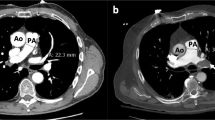Abstract
Purpose
To retrospectively assess the correlation between pulmonary arterial obstruction index (PAOI) and right lateral ventricular wall thickness with in-hospital mortality in patients with acute pulmonary embolism.
Methods
CT angiography (CTA) of 55 consecutive patients (30 males; 25 females; mean age ± SD, 59 ± 11 years) with proven acute pulmonary embolism was investigated. PAOI was determined according to the Qanadli score on CTA. Right ventricular lateral wall thickness was also measured, and patients’ in-hospital mortality was recorded. The correlation between PAOI and mortality, right ventricular lateral wall thickness and mortality, and PAOI and right ventricular lateral wall thickness was evaluated.
Results
PAOI was 23.6 and 10.4 in patients with and without in-hospital mortality, respectively (P < 0.001). Right ventricular lateral wall thickness was 8.7 mm and 7.5 mm in patients with and without in-hospital mortality, respectively (P < 0.001). PAOI more than 21.5 and right ventricular lateral wall thickness more than 8.75 were predictive of in-hospital mortality with a high accuracy. Also, PAOI and right ventricular lateral wall thickness had a significant correlation with each other (P < 0.001; r = 0.695).
Conclusion
PAOI and right ventricular lateral wall thickness on CTA were highly predictive of in-hospital mortality in patients with pulmonary embolism. Right ventricular lateral wall thickness and PAOI had a significant correlation with each other as well.





Similar content being viewed by others
References
van der Meer RW, Pattynama PM, van Strijen MJ et al (2005) Right ventricular dysfunction and pulmonary obstruction index at helical CT: prediction of clinical outcome during 3-month follow-up in patients with acute pulmonary embolism. Radiology 235:798–803
Bazeed MF, Saad A, Sultan A, Ghanem MA, Khalil DM (2010) Prediction of pulmonary embolism outcome and severity by computed tomography. Acta Radiol 51(3):271–276
Meinel FG, Nance JW Jr, Schoepf UJ, Hoffmann VS, Thierfelder KM, Costello P, Goldhaber SZ, Bamberg F (2015) Predictive value of computed tomography in acute pulmonary embolism: systematic review and meta-analysis. Am J Med 128(7):747–759
Qanadli SD, El Hajjam M, Vieillard-Baron A et al (2001) New CT index to quantify arterial obstruction in pulmonary embolism: comparison with angiographic index and echo-cardiography. AJR Am J Roentgenol 176:1415–1420
Metafratzi ZM, Vassiliou MP, Maglaras GC (2006) Acute pulmonary embolism: correlation of CT pulmonary artery obstruction index with blood gas values. AJR Am J Roentgenol 186(1):213–219
Lu MT, Demehri S, Cai T, Parast L, Hunsaker AR, Goldhaber SZ, Rybicki FJ (2012) Axial and reformatted four-chamber right ventricle-to-left ventricle diameter ratios on pulmonary CT angiography as predictors of death after acute pulmonary embolism. AJR Am J Roentgenol 198(6):1353–1360
Furlan A, Aghayev A, Chang CC et al (2012) Short-term mortality in acute pulmonary embolism: clot burden and signs of right heart dysfunction at CT pulmonary angiography. Radiology 265(1):283–293
Ghaye B, Ghuysen A, Willems V, Lambermont B, Gerard P, D'Orio V, Gevenois PA, Dondelinger RF (2006) Severe pulmonary embolism: pulmonary artery clot load scores and cardiovascular parameters as predictors of mortality. Radiology 239:884–891
Inönü H, Acu B, Pazarlı AC, Doruk S, Erkorkmaz Ü, Altunkaş A (2012) The value of the computed tomographic obstruction index in the identification of massive pulmonary thromboembolism. Diagn Interv Radiol 18(3):255–260
Matthews JC, McLaughlin V (2008) Acute right ventricular failure in the setting of acute pulmonary embolism or chronic pulmonary hypertension: a detailed review of the pathophysiology, diagnosis, and management. Curr Cardiol Rev 4(1):49–59
Bryce YC, Perez-Johnston R, Bryce EB et al (2019) Pathophysiology of right ventricular failure in acute pulmonary embolism and chronic thromboembolic pulmonary hypertension: a pictorial essay for the interventional radiologist. Insights Imaging 10(1):18
Author information
Authors and Affiliations
Corresponding author
Ethics declarations
This study was conducted with the approval of our local institutional review board.
Conflict of interest
The authors declare that they have no conflict of interest.
Additional information
Publisher’s note
Springer Nature remains neutral with regard to jurisdictional claims in published maps and institutional affiliations.
Rights and permissions
About this article
Cite this article
Faghihi Langroudi, T., Shabestari, A.A., Hekmati, S. et al. Association between pulmonary arterial obstruction index and right lateral ventricular wall thickness with in-hospital mortality in patients with acute pulmonary embolism. Emerg Radiol 28, 327–331 (2021). https://doi.org/10.1007/s10140-020-01871-5
Received:
Accepted:
Published:
Issue Date:
DOI: https://doi.org/10.1007/s10140-020-01871-5




